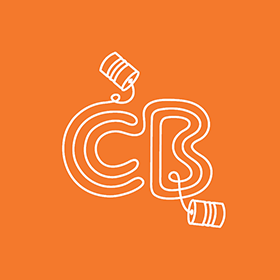Oral Myofunctional Therapy to Eliminate Tongue Thrust using the SMILE Program by Robyn Merkel-Walsh and Sara R. Johnson (TalkTools)
According to ASHA, Oral Myofunctional Disorders (OMD) is when the tongue moves forward in an exaggerated way during speech and/or swallowing. The tongue may lie too far forward during rest or may protrude between the upper and lower teeth during speech and swallowing, and at rest. Although a “tongue thrust” swallow is normal in infancy, it usually decreases and disappears as a child grows. By age 3 years, a child will typically develop a mature swallow and the tongue thrust is usually resolved. However a tongue thrust may persist due factors such as thumb sucking, cranio-facial abnormalities, allergies, repeated ear infections and Down’s Syndrome. In terms of speech, the most obvious impact of a tongue thrust is during the production of /s/, /z/, /sh/, /ch/, and /j/. The sounds appear distorted and will often attract listener attention due to the atypical quality. In addition, the /t/, /d/, /n/ and /l/ may also appear impacted.
Robyn Merkel-Walsh’s SMILE (SysteMatic Intervention for Lingual Elevation) program is a fun therapy program for tongue thrust or Oral Myofunctional Disorder. I particularly like this program because it is based on Sara R. Johnson’s Oral Placement Therapy. The program utilizes the oral-motor prerequisites (horn hierarchy, straw hierarchy, bite block hierarchy) that forms an essential part of my treatment program for my children with speech production disorders. It combines oral-motor, swallowing and articulation therapy techniques to treat myofunctional disorders.
The program is designed for children 7 years and older. She uses child-friendly terms such as the “Smile Spot” (alveolar ridge), the “Smile Swallow,” (mature swallow), and sad swallow (reverse swallow). The program taps into the meta-cognitive abilities by building the child’s awareness of the “SMILE parts” (cheeks, tongue tip, palate, teeth, lips, etc.).
The lessons are hierarchical, systematic and the progress is measurable. The first lesson includes cheek exercises, while the second targets the lips. The second lesson includes exercises to work on lip seal, lip rounding, lip strength, tone and dissociation. At this point the program also includes articulation drills for lip sounds (/p/, /b/, /m/ and /w/). The third lesson works on building appropriate oral posture at rest. The program uses “cute” illustrations of Mr. SMILE to demonstrate the difference between good oral posture and poor oral posture at rest. The exercises in this lesson use a variety of tools such as a nose flute to establish volitional nasal airflow. This is followed by exercises to maintain lip and jaw closure. The final aspect to this lesson is appropriate tongue placement (at the SMILE Spot) at rest. Lesson four A.K.A. the “Lazy Tongue Buster” incorporates a group of exercises that targets tongue protrusion (as a precursor to tongue retraction), tongue retraction, tongue lateralization and tongue elevation. This lesson also includes the articulation drills for tongue sounds /t/, /d/, /l/, /n/, /k/, /g/. Lesson five targets the oral habits often associated with myofunctional disorders such as thumb sucking, biting fingernails, biting bottom lip, chewing on pencils, leaving the mouth open, and licking lips. The assumption here is that these habits will interfere with developing a new tongue position and a mature swallow. Lesson six is essentially a review of the previous lessons. Lesson seven through ten teaches the “New Swallow” – with liquids and solids. Lesson eleven focuses on making the new swallow a daily habit. This lesson also targets the appropriate placement of tongue for articulation of /s/, /l/, /sh/, and /ch/. Lesson twelve is also a review lesson of all previous lessons. Lesson thirteen and fourteen consist of maintenance exercises for the new swallow and tongue placement to ensure that it is generalized and essentially a part of the child’s daily behavior.
The systematic, simple and well laid out program make it easy and fun for the children and the families to follow. The homework practice charts make it easy to log the children’s performance at home and ensure progress. Overall, I think the SMILE program is complete, holistic approach to remediate oral myofunctional disorders or tongue thrusts.
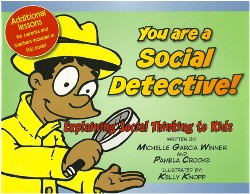 Getting started with the Social Thinking Curriculum by Michelle Garcia Winner is always a challenge. Most of us, Speech-Language Pathologists, fall under two distinct categories: 1) “Read first Therapists” that like to read and study a program until it we can recite it in our sleep before we will begin to implement it on our students, 2) “Try it out first Therapists” that will try to figure out the program while we implement it on our students.
Getting started with the Social Thinking Curriculum by Michelle Garcia Winner is always a challenge. Most of us, Speech-Language Pathologists, fall under two distinct categories: 1) “Read first Therapists” that like to read and study a program until it we can recite it in our sleep before we will begin to implement it on our students, 2) “Try it out first Therapists” that will try to figure out the program while we implement it on our students.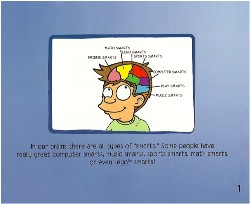
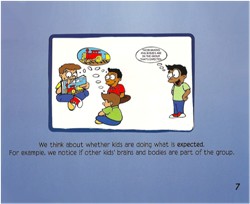 Versus
Versus 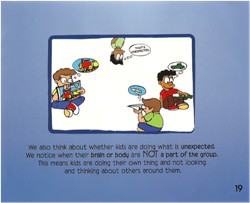
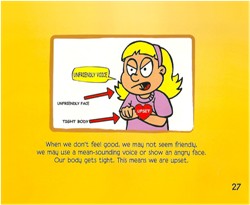 The book also explains “being upset” in explicit physical terms (mean sounding voice, angry face, body gets tight) so children can identify their own states when they get upset.
The book also explains “being upset” in explicit physical terms (mean sounding voice, angry face, body gets tight) so children can identify their own states when they get upset.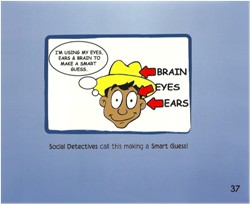 Another challenge a lot of my little ones have is identifying and differentiating between peers who are nice and friendly and others who say or do mean things. The book has tables (page 44 and 45) to help the child identify and list characteristics of a “nice person” and a person who is “not nice to talk to.” In addition, the book also has a glossary with definitions of the Social Thinking vocabulary for quick reference. The book also includes three lesson plans at the end of the book for “Expected Vs Unexpected Behaviors,” “Social Spy,” and “Social Detective.”
Another challenge a lot of my little ones have is identifying and differentiating between peers who are nice and friendly and others who say or do mean things. The book has tables (page 44 and 45) to help the child identify and list characteristics of a “nice person” and a person who is “not nice to talk to.” In addition, the book also has a glossary with definitions of the Social Thinking vocabulary for quick reference. The book also includes three lesson plans at the end of the book for “Expected Vs Unexpected Behaviors,” “Social Spy,” and “Social Detective.”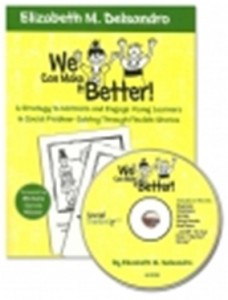 A majority of my caseload includes preschool and early elementary aged students. Many of them are diagnosed with Autism or demonstrate social skill deficits. If you’re like me and work with the younger students, you know how hard it is to find social skill programs that are structured, but still age appropriate. For the last year or so, the Social Thinking Curriculum has been the go-to program for many therapists to build social skills. However, finding materials that are appropriate for this age group has always been a challenge. In many settings including the public schools the Social Thinking curriculum isn’t incorporated until upper elementary or middle school years. Does that mean that the Social Thinking Curriculum isn’t appropriate for the preschool age group? In my opinion the preschool and early elementary age group is ideal to begin teaching the Social Thinking Curriculum. Introducing the Social Thinking vocabulary and concepts early on makes them a part of their everyday lives and routine. It does present unique challenges though: 1) teaching the vocabulary in ways that makes sense to younger students and 2) preparing lessons that are age appropriate, engaging and flexible.
A majority of my caseload includes preschool and early elementary aged students. Many of them are diagnosed with Autism or demonstrate social skill deficits. If you’re like me and work with the younger students, you know how hard it is to find social skill programs that are structured, but still age appropriate. For the last year or so, the Social Thinking Curriculum has been the go-to program for many therapists to build social skills. However, finding materials that are appropriate for this age group has always been a challenge. In many settings including the public schools the Social Thinking curriculum isn’t incorporated until upper elementary or middle school years. Does that mean that the Social Thinking Curriculum isn’t appropriate for the preschool age group? In my opinion the preschool and early elementary age group is ideal to begin teaching the Social Thinking Curriculum. Introducing the Social Thinking vocabulary and concepts early on makes them a part of their everyday lives and routine. It does present unique challenges though: 1) teaching the vocabulary in ways that makes sense to younger students and 2) preparing lessons that are age appropriate, engaging and flexible.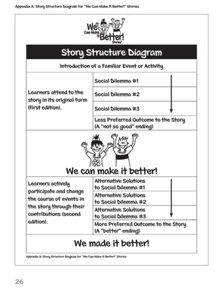 Appendix A describes the story structure. The first edition contains the social dilemmas, while the second provides solutions so the ending is a preferred ending.
Appendix A describes the story structure. The first edition contains the social dilemmas, while the second provides solutions so the ending is a preferred ending.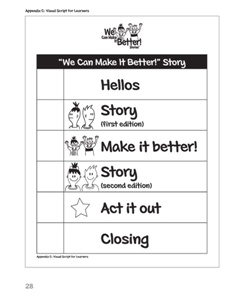 Appendix C provides a visual script for the lesson.
Appendix C provides a visual script for the lesson.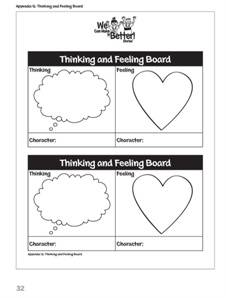 Appendix G provides a visual link between people’s thoughts and their feelings. This could be a very powerful and versatile tool. It could be used for far more activities than just the lessons in this program.
Appendix G provides a visual link between people’s thoughts and their feelings. This could be a very powerful and versatile tool. It could be used for far more activities than just the lessons in this program.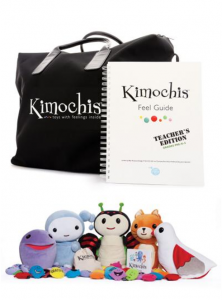 After 11 years in the field, I finally came across a curriculum that made teaching emotions a fun and positive learning experience. I was fortunate enough to be able to attend a presentation by Diann Grimm, M.A., CCC-SLP, Ed. S. on the Kimochi Curriculum. Kimochis in Japanese mean feelings. The program incorporates Kimochi characters with a pocket to place their Kimochis (emotions). Each Kimochi is a soft pillow with the feelings printed on one side and the corresponding facial expression on the other side. Using the Kimochis in conjunction with the feelings lessons as a part of the curriculum allows the children to learn to identify and express their emotions in a safe and focused manner. It fosters Social-Emotional Learning (SEL) which is a critical adjunct to the Social Thinking ® curriculum proposed by Michelle Garcia Winner. The adorable toys and the fun and child-friendly curriculum is a great way to support positive behavior, self awareness, social awareness, self management, relationship skills and decision making. It appears that some of the early research using this curriculum has shown positive results for children with Social-Emotional Learning difficulties (e.g. children on the Autism Spectrum). In addition, this curriculum has also been used for typical children in general education classrooms. I am so pleased and excited to offer the Kimochi Curriculum as a part of the Social Thinking groups. I think it will be an important piece to the puzzle that addresses the “Feelings-Communication-Behavior link” that Diann Grimm talks about.
After 11 years in the field, I finally came across a curriculum that made teaching emotions a fun and positive learning experience. I was fortunate enough to be able to attend a presentation by Diann Grimm, M.A., CCC-SLP, Ed. S. on the Kimochi Curriculum. Kimochis in Japanese mean feelings. The program incorporates Kimochi characters with a pocket to place their Kimochis (emotions). Each Kimochi is a soft pillow with the feelings printed on one side and the corresponding facial expression on the other side. Using the Kimochis in conjunction with the feelings lessons as a part of the curriculum allows the children to learn to identify and express their emotions in a safe and focused manner. It fosters Social-Emotional Learning (SEL) which is a critical adjunct to the Social Thinking ® curriculum proposed by Michelle Garcia Winner. The adorable toys and the fun and child-friendly curriculum is a great way to support positive behavior, self awareness, social awareness, self management, relationship skills and decision making. It appears that some of the early research using this curriculum has shown positive results for children with Social-Emotional Learning difficulties (e.g. children on the Autism Spectrum). In addition, this curriculum has also been used for typical children in general education classrooms. I am so pleased and excited to offer the Kimochi Curriculum as a part of the Social Thinking groups. I think it will be an important piece to the puzzle that addresses the “Feelings-Communication-Behavior link” that Diann Grimm talks about.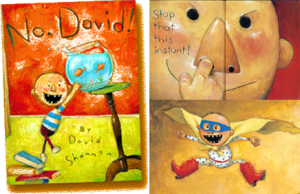 Putting a lesson together to teach the concept of “expected/ unexpected behaviors” using “No David!” would be fairly easy for most experienced clinicians. However, for me, having the resource list of children’s books that teach specific Social Thinking concepts makes Audra Jensen’s book an incredibly handy tool. An additional benefit of using children’s literature as a tool is that lessons can be planned for individual (one-on-one sessions) as well as groups.
Putting a lesson together to teach the concept of “expected/ unexpected behaviors” using “No David!” would be fairly easy for most experienced clinicians. However, for me, having the resource list of children’s books that teach specific Social Thinking concepts makes Audra Jensen’s book an incredibly handy tool. An additional benefit of using children’s literature as a tool is that lessons can be planned for individual (one-on-one sessions) as well as groups.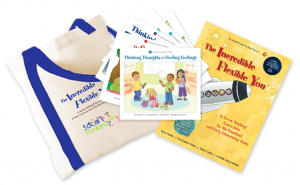 The area of language disorders that seemed to confound most therapists, including myself, for a long time was social skills or pragmatics. That was until I discovered Michelle Garcia Winner’s work. When I read her book “Thinking About YOU, Thinking About ME,” I finally felt relief. I started thinking about social skills in a completely different way that made sense. I realized that the reason my therapy tools didn’t seem powerful or effective was because I was focusing on teaching specific skills (e.g. How to start a conversation) in a specific situation (e.g. When you meet your neighbor), rather than teaching social thinking or social cognition. As a clinician, when you teach a specific skill in an artificial environment, the student may do well to learn the skill. But the questions “What happens when the situation changes? Can my student generalize this skill to another environment?” always haunted me. The knowledge that you can build a child’s perspective taking ability, or his ability to “listen with his whole body” to help him across situations and contexts, was my Eureka moment.
The area of language disorders that seemed to confound most therapists, including myself, for a long time was social skills or pragmatics. That was until I discovered Michelle Garcia Winner’s work. When I read her book “Thinking About YOU, Thinking About ME,” I finally felt relief. I started thinking about social skills in a completely different way that made sense. I realized that the reason my therapy tools didn’t seem powerful or effective was because I was focusing on teaching specific skills (e.g. How to start a conversation) in a specific situation (e.g. When you meet your neighbor), rather than teaching social thinking or social cognition. As a clinician, when you teach a specific skill in an artificial environment, the student may do well to learn the skill. But the questions “What happens when the situation changes? Can my student generalize this skill to another environment?” always haunted me. The knowledge that you can build a child’s perspective taking ability, or his ability to “listen with his whole body” to help him across situations and contexts, was my Eureka moment.